Key Insights
- The number of active validators on BNB Smart Chain (BSC) grew 10% QoQ, from 29 to 31. At the same time last year, there were only 21 validators on BSC.
- The circulating supply of BNB declined 1.3% in Q3 due to BNB’s token-burning mechanism. In Q3, it burned 13,400 BNB ($3.1 million), 23% less than in the previous quarter. This translates to an annualized inflation of -5.8% in Q3, keeping BNB deflationary as in previous quarters.
- DeFi total value locked (TVL) in BNB terms remained stagnant throughout Q3. However,h BNB’s 23% price decline led to the TVL measured in USD to also decline by 23%.
- The decline in BNB price (-23%), daily transactions (-14%), and daily transaction fees in BNB (-12%) led revenue from all fees collected by the protocol measured in USD to fall by 41% QoQ.
- BNB Chain launched its optimistic rollup, opBNB, in Q3 and made progress in developing BNB Greenfield (storage network), planned to launch in Q4.
Primer on BNB Chain
Build N Build Chain (BNB Chain) is an ecosystem of blockchains, where each chain serves a particular function. The five core components of BNB Chain are as follows:
- BNB Beacon Chain: staking and governance layer
- BNB Smart Chain: smart contract layer
- BNB Greenfield: storage network
- opBNB: optimistic rollup
- zkBNB: zero-knowledge rollup (BNB Chain plans to merge opBNB with zkBNB into one canonical zk-rollup solution)
The metrics in this report will focus on BNB Smart Chain (BSC). BSC is an EVM-compatible, layer-1 blockchain secured by a form of Proof-of-Staked-Authority (PoSA) that combines aspects of Proof-of-Authority (PoA) and Delegated Proof-of-Stake (DPoS). In PoSA on BSC, the validator set is of fixed size and is elected by stake weight (staked plus bonded). In addition, validators must continue staking assets to secure the network, and validators chosen to produce blocks are rotated (not based on stake weight).
Messari’s BNB Chain Ecosystem Analysis contains a comprehensive overview of all components of BNB Chain.
Key Metrics
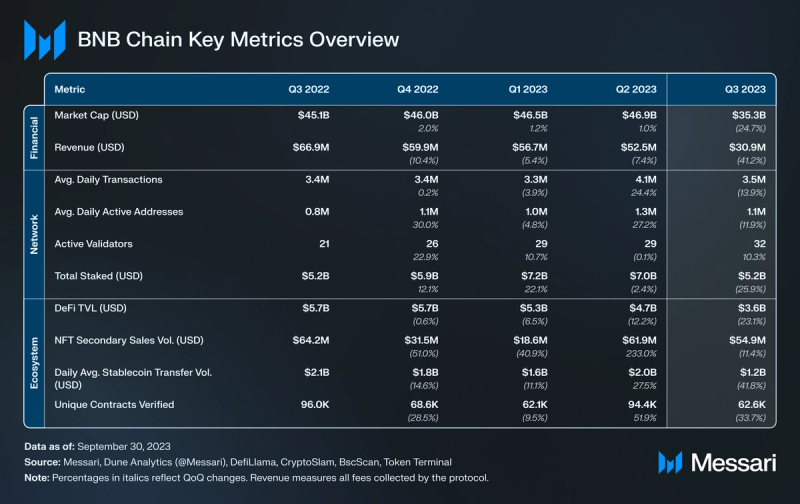
Performance Analysis
Financial Overview
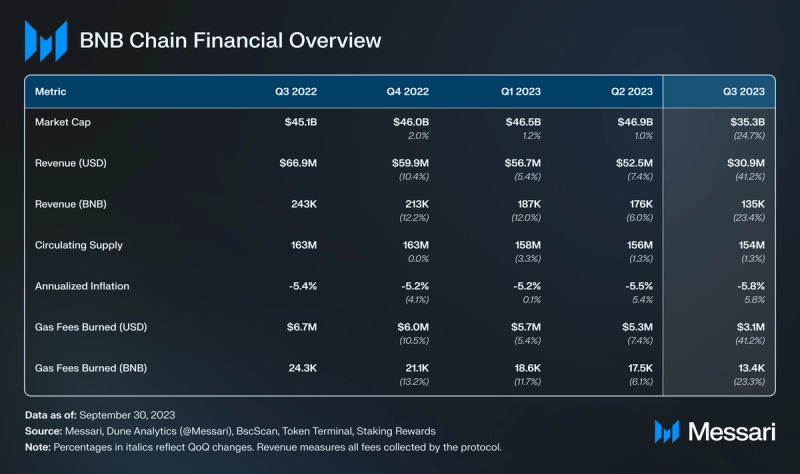
BNB Chain has separated itself from Binance (its launching entity and the largest centralized crypto exchange); however, the market does not appear to fully recognize this separation.
Throughout Q3, Binance lost partnerships, shut down lines of business, conducted layoffs, saw resignations from executives, and was accused of violating sanctions. This all compounds the allegations by the Securities and Exchange Commission (SEC) from Q2. The SEC claimed that several exchanges (including Binance.US) engaged in unregistered offers and sales of cryptoasset securities, including BNB.
The Binance-related events that occurred during Q3 coincided with the downward pressure on the value of BNB, which declined 25% QoQ. By contrast, the entire market value only dropped by 9% QoQ. And some Layer-1s, notably Solana and XRP Ledger, grew by 17% and 12%, respectively. Regardless, BNB maintained its position as the fourth-largest cryptoasset by market capitalization, at $35.3 billion.
The circulating supply of BNB also declined in Q3 (-1.3%) due to BNB’s token-burning mechanism. In Q3, it burned 13,400 BNB ($3.1 million), 23% less than in the previous quarter. This led to an annualized inflation of -5.8% in Q3, keeping BNB deflationary as in previous quarters.
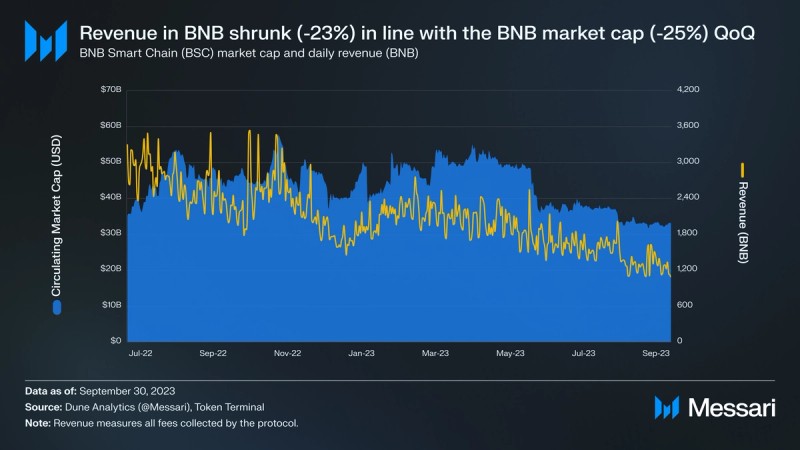
All transactions on blockchains require computation, and fees reflect the complexity of performing such computations. This is why smart contract calls are more expensive than simple transfers. BNB Chain’s Q3 onchain activity reflected market speculation as BNB Smart Chain’s revenue (measured in BNB) fell in-line with the BNB market cap (-23% and -25%, respectively). Because revenue is measured as all fees collected by the protocol, it reflects the activity on BSC. Transactions, a component of the fall in revenue, declined by 14% QoQ. As BNB Chain’s principal on/offramp for users, Binance’s adverse events throughout the quarter may have influenced activity, leading to a decline in transactions and, subsequently, a decline in revenue.
Network Overview
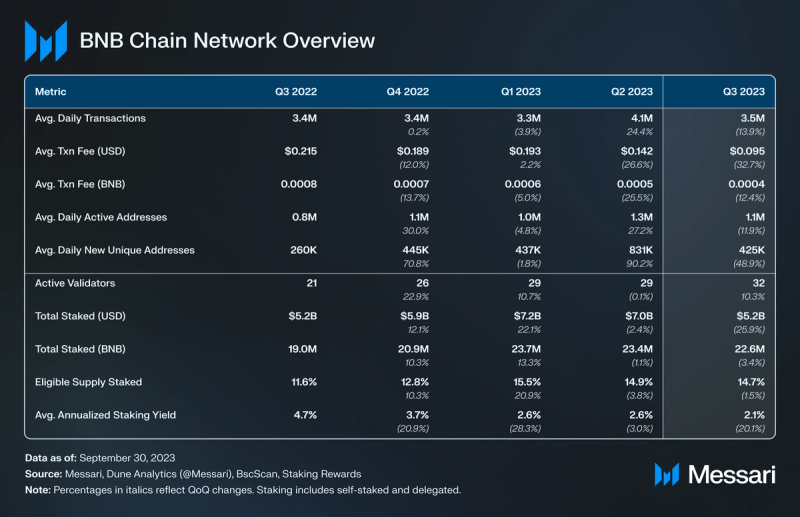
In-line with the 14% decline in daily transactions, the average fee in BNB dropped by 12%. The drop suggests that users in Q3 were performing less complex tasks on BSC, potentially affecting the QoQ fall in fee price and revenue. Despite the network adding support for three new validators (a 10% increase QoQ), other validator metrics remained relatively stable in Q3. Total stake and the eligible supply staked (total stake divided by total supply) only declined by 3% and 2% QoQ, respectively. However, the average annualized staking yield continued to fall, decreasing from 2.6% to 2.1% QoQ.
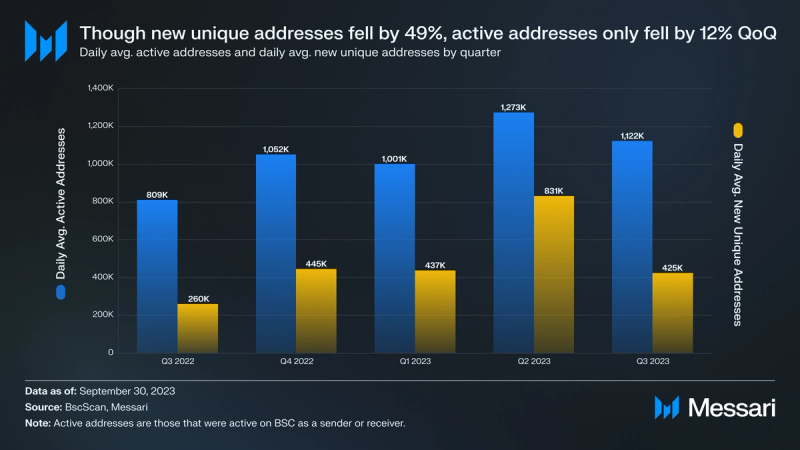
Despite a 49% decline in daily average new unique addresses on BSC, the daily average number of active addresses only declined by 12%, maintaining levels above 1.1 million. These decreases followed BSC’s strongest quarter in adding active and new unique addresses. While fewer active addresses were lost this quarter than were added, the launch of opBNB may have attracted new users, potentially diverting them from BSC.
However, the relative stickiness in active addresses amidst the current bear market may have been a result of newer applications on BSC that either grew users or gained existing BSC users. Notable SocialFi applications include Friend3, a friend.tech-adjacent messaging application that launched in late August, and XCAD Network, a watch-to-earn platform that grew unique active wallets (UAW) by 1,323% QoQ.
Additionally, TinyTap, a code-free platform for educators to create interactive educational content, grew its active users again in Q3. After growing significantly in Q2, averaging 30,000 daily UAW, TinyTap continued this trend upward in Q3, averaging 35,000 daily UAW throughout the quarter. Regardless, these top applications could only mitigate, not subvert, the turnover of addresses on the entire chain.

DeFi applications are responsible for many of the complex and expensive transactions that occur on smart contract platforms. The value locked in DeFi on BSC (in BNB terms) was relatively steady in Q3. While value locked is not the same as volume, changes measured in BNB tend to reflect changes in activity measured in BNB. Other heavy volume sectors like stablecoin transfers and GameFi experienced 42% and 19% QoQ declines, respectively. Simultaneously, daily transactions and the average daily transaction fee in BNB both dropped by 13%. DeFi may have helped anchor these declines to not fall as low as other sectors.
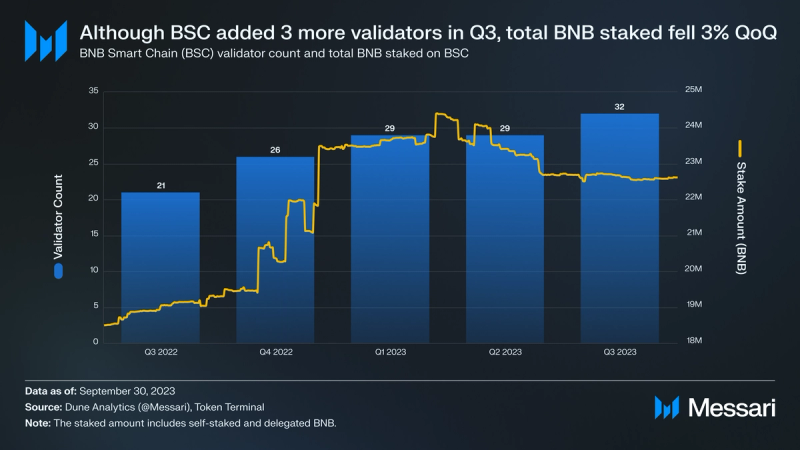
BSC continued adding validators in Q3, following the upward trend throughout the year. This 10% QoQ was largely made possible due to the implementations of BEP-131 and BEP-159. BEP-131 introduced candidate validators onto BSC, which essentially created the role of backup validators should there be any issues with active validators. And BEP-159 introduced a permissionless validator election mechanism.
While the validator count grew in Q3, staked BNB declined by 3%, and the circulating supply staked also fell by 2% QoQ. This decrease in staked BNB largely began at the start of Q2 and has continued to trend downward. The continued fall in BNB staked may be a result of BNB staking becoming less attractive throughout each quarter. Throughout the year, the annualized reward rate has steadily decreased, falling from 2.6% to 2.1% QoQ.
Ecosystem and Development Overview
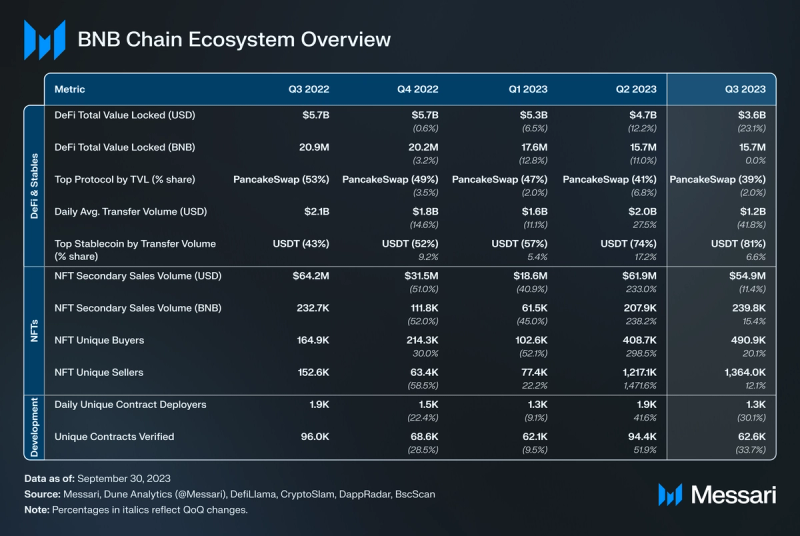
The NFT space on BSC performed the strongest among other sectors. Secondary sales volume in BNB increased by 15%, and unique buyers and sellers also grew by 20% and 12%, respectively. While DeFi TVL in BNB maintained the same position as the previous quarter, stablecoin transfer volume plummeted by 42%. In addition, the number of unique contract deployers and verified contracts both fell by over 30%. Despite these QoQ changes, BNB Chain continued to launch new products and implement updates within its ecosystem.

The distribution of TVL among DeFi protocols followed the Q2 trend of distributing dominance, also evening out in Q3. Though the top five DeFi protocols fell in TVL throughout the quarter, the daily average TVL became more distributed as the average TVL on PancakeSwap (the largest DeFi protocol on BSC by TVL) dropped by 28%. Though Biswap’s average TVL halved QoQ, it accounted for less than 2.5% of the total DeFi TVL on BSC.
This trend of distributing TVL more evenly across protocols demonstrates a more robust DeFi ecosystem. In Q3 2023, PancakeSwap accounted for 53% of the TVL on BSC. Now it accounts for only 39%, despite launching revenue-sharing pools for CAKE holders in August. During the same time, Venus Finance’s TVL rose from 18% to 31%, further increasing the competition for user liquidity.
Stablecoins

Though BUSD started modestly losing its share of the market toward the end of 2022, events in Q1’23 began pushing liquidity out of BUSD at a faster pace:
- January 2023: Binance admitted that stablecoin pegged BUSD had a $1 billion gap in collateral.
- February 2023: NYDFS investigated Paxos over BUSD and ordered it to cease BUSD issuance.
- March 2023: Coinbase suspends BUSD stablecoin trading.
Following the events from Q1’23, BUSD’s net transfer volume fell by roughly $31 billion, while the remaining market’s net transfer volume fell by about $3 billion (excluding BUSD). Despite all stablecoin volumes falling QoQ, USDT’s transfer volume reached $86 billion in Q3’23, now accounting for nearly 81% of the total stablecoin volume on BSC. Both BUSD and USDC accounted for $11 billion and $9 billion, respectively, in Q3’23.
Other
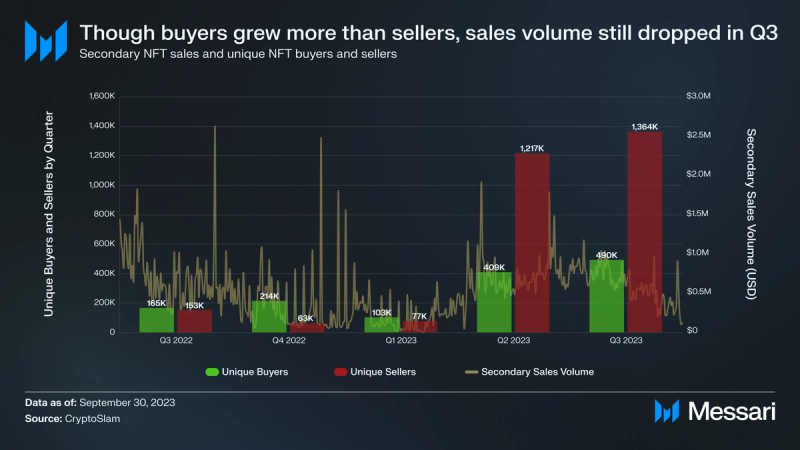
Although secondary NFT sales volume fell by 11% in Q3, the number of unique NFT buyers and sellers grew by 19% and 11%, respectively, despite declines across the broader market. The growth in unique buyers and sellers followed large increases from the previous quarter (up 294% and 1,454%, respectively). Transactions also increased in Q3, indicating that the average sale price per transaction dropped.

In Q3, the top five social dApps by UAW and Q3 volume (both groups had 100% overlap) on BSC attracted almost 32,000 unique active wallets (UAW). The number nearly equaled the top five GameFi applications by UAW, which drew over 32,000 UAW. However, SocialFi UAW vastly outperformed the UAW attracted by the top five GameFi dApps by volume by almost 300%. Despite attracting a lot of users, SocialFi did not contribute to a large amount of the value transfer on BSC. In Q3, the top five SocialFi applications only facilitated $4.7 million in transfer volume. Meanwhile, the top five GameFi dApps by volume generated $18.2 million, with Alien Worlds and MOBOX accounting for $8.9 million and $7.6 million, respectively.

opBNB is an EVM-compatible optimistic rollup that helps scale execution throughput for BSC. After its testnet in June 2023, opBNB launched its mainnet for infrastructure providers in mid-August 2023. It saw net inflows of $4.7 million in BNB and BUSD. The total value bridged (TVB) peaked at roughly $6.4 million in late August and shrunk to $3.4 million in early September. On September 11, despite a low volume, opBNB experienced inflows of five additional assets: CAKE, FDUSD, BTCB, ETH, and USDT. Two days later, opBNB announced the launch of its mainnet and immediately saw a burst of additional liquidity. Though the total value bridged has not surpassed what it was when opBNB initially launched, the TVB has grown 23% since the mainnet announcement, reaching $4.7 million by the end of September.
Development
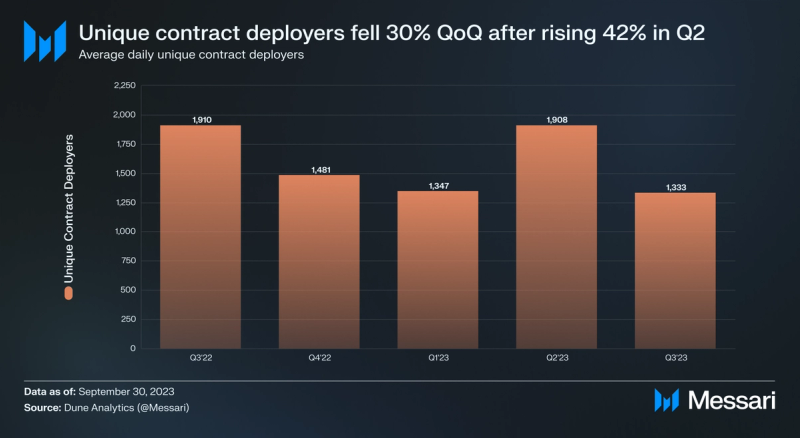
Developer activity on BSC cooled off in Q3 as BNB Chain made strides in other ecosystem efforts — like launching opBNB mainnet and preparing to launch BNB Greenfield on mainnet. While Q2 saw the most unique contract deployers over the past year, Q3 experienced the fewest. The change came as efforts to grow activity on new ecosystem chains expanded and the BNB market cap faced its sharpest decline in a year (–25%). As expected, the number of contracts verified closely followed the pattern of unique contract deployers. Despite BNB Chain’s continued efforts to foster greater development in the ecosystem, the number of verified contracts dropped by 34% QoQ.
Ecosystem Growth Strategy
The drivers of BNB Chain’s network activity and fundamental value accrual include its growth strategy to attract developers and grow its ecosystem. BNB Chain has established several growth initiatives that continued through Q3 2023, including:
- Most Valuable Builder (MVB) Accelerator Program — In the sixth season of this program in collaboration with Binance Labs, MVB received over 1,400 applications. Twelve projects ultimately competed, and only four were selected for investment by Binance Labs: AltLayer (infrastructure), KiloEx (DeFi), Kinza (DeFi), and Sleepless AI (gaming).
- Builder Grants — The program awards dozens of grants to not-for-profit projects each quarter for the creation of public goods.
- Gas Grants — The program incentivizes projects that contribute to the BNB Chain ecosystem by providing them with gas fee grants proportional to their monthly gas fee volume. The total pool for these gas grants is fixed at $200,000 in BNB tokens each month, with individual projects receiving up to $15,000 monthly. In July, 29 projects received grants; in August, 20 received grants; and in September, 23 received grants.
- Kickstart — Provides tools and services to help projects kick-start their development.
- Advisory Support — Builders can request advisory services from BNB Chain that cover tokenomics and technical infrastructure.
- Hackvolution — This one-and-a-half-month hackathon focused on development in Infrastructure, Gaming, DeFi, and AI. It occurred in Q3 and awarded 16 teams between $2,000 and $14,000 out of a $72,000 total prize pool. Codex Field won the top prize among infrastructure protocols, and Op-Intents won the top prize among AI protocols.
Qualitative Analysis
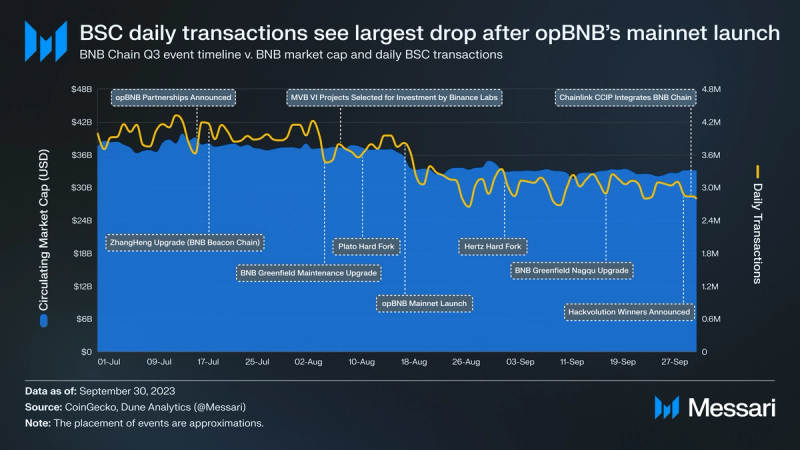
BNB Chain maintains a large user base, consistently pushes new developments, and fosters an active community around the ecosystem.
Launch of opBNB
opBNB is an EVM-compatible optimistic rollup that launched on mainnet in August 2023 and was built using Optimism’s OP Stack. It leverages the Bedrock release while introducing several performance and compatibility enhancements tailored to the BNB Chain ecosystem. After aggregating a random sample of 50+ opBNB transactions, we calculated a median gas fee of roughly $0.005. In the future, the opBNB state will merge with the zkBNB proving mechanism, transitioning opBNB into a zk-rollup as the canonical Layer-2 solution on BNB Chain.
Launch of BNB Greenfield
BNB Greenfield is a blockchain and storage network that aims to synergize its natively offered decentralized cloud storage with the smart contract functionality of BNB Smart Chain (BSC). While BNB Greenfield does not support a generalized application layer like the EVM, it will include a native cross-chain bridge between itself and BSC. The bridge will enable developers to integrate BSC smart contracts with its decentralized storage services. The BNB Greenfield mainnet is set to launch in Q4 2023.
Technical Developments
BNB Chain continued improving BSC and BNB Beacon Chain throughout Q3. The main technical developments are listed below.
- ZhangHeng Upgrade (BNB Beacon Chain) — This hard fork upgrade went live on July 19, 2023. It fixed a few bugs, patched a security issue, and implemented the following BEP:
- BEP-255: Includes an asset reconciliation feature that will halt BNB Beacon Chain block production upon discovering reconciliation errors while tracking user balances. This update attempts to improve security and could potentially prevent hacks like the $100 million cross-chain bridge exploit from October 2022.
- Plato Hard Fork — As a part of the V1.2.9 update of the BSC Mainnet, Plato went live on August 10, 2023, and implemented the following BEP:
- BEP-126: Introduces the “Fast Finality Mechanism,” which reduces the time to finality (probabilistically) on BSC from 14 to up to 2 blocks. This update should minimize the risk of chain re-organizations and stabilize block production.
- Hertz Hard Fork— As a part of the V1.2.9 update of the BSC Mainnet, Hertz went live on August 30, 2023. Hertz ported some of the London and Berlin upgrades from Ethereum to BSC. However, it did not introduce a new burn mechanism or the concept of a gas tip. The Hertz hard fork implemented the following BEPs:
- London-focused BEPs include BEP-212, BEP-226, BEP-227, and BEP-228. These BEPs collectively work toward optimizing onchain resource utilization, enhancing security, and improving transaction fee processes.
- Berlin-focused BEPs include BEP-225, BEP-229, BEP-230, BEP-231. These BEPs aim to refine gas cost calculations, introduce flexibility in transaction structures, enhance security against potential attacks, and optimize transaction efficiency.
CCIP Integration
Chainlink’s Cross-Chain Interoperability Protocol (CCIP) integrated BNB Chain in Q3. CCIP facilitates cross-chain communication. It also enables developers to build applications that can transfer data and assets between CCIP-supported networks. At the time of writing, Chainlink has yet to open the CCIP mainnet to the public.
Hashdit Integrations
Hashdit is a firm focused on providing threat intelligence information to users. It powers the Red Alarm, which publishes all dApps and smart contracts assessed to be scams or high-risk. In August 2023, Hashdit reported that losses due to security incidents on BSC fell by 60% month-over-month, from $11.3 million to $4.5 million. Hashdit also integrated its security API with PancakeSwap, TrustWallet, and BscScan to improve user safety and security across the BNB Chain ecosystem. As a result, PancakeSwap now displays risk scores for tokens; Trust Wallet notifies users of risks before signing transactions; and BscScan displays risk warnings directly in the explorer.
Closing Summary
BNB Chain continues to be one of the most highly valued projects in the space. At the end of the quarter, it boasted a market cap of $35.3 billion, despite a 23% fall in the price of BNB. In Q3, DeFi held steady in BNB terms, with the USD-value of TVL falling 23% due to the drop in price. BNB also continued its deflationary trend, with the circulating supply decreasing by 1.3%. Additionally, the active validator set on BSC grew by 10% QoQ, from 29 to 31. However, revenue in USD terms continued to slump, falling by 41% QoQ.
Despite market activity, BNB Chain shipped products and implemented technical upgrades in Q3. It launched opBNB on mainnet in August and underwent a series of upgrades reflecting Ethereum’s London and Berlin hard forks. BSC added functionality to optimize transaction efficiency, enhance security, and refine gas cost calculations. BNB Chain is poised to have an active Q4 as it plans to launch BNB Greenfield as it experiences the results of its ecosystem efforts and new developments.
——
















